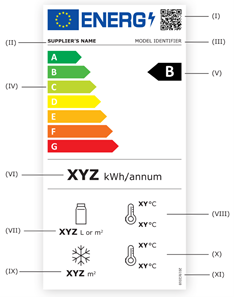Energy labelling - FAQ
To ensure the conformity and allow MSAs verifications, the manufacturer’s product documentation, EPREL declaration, Energy Label, CE declaration, sales order, and associated invoices, must relate to the specific product as it is placed on the market. This documentation shall include all the components/accessories influencing the EEI of the specific unit at the time of placing on the market.
The product modifications done after the placing on the market do not alter the energy label originally supplied by the manufacturer.
The energy label must be clearly displayed in any point of sale of the refrigerating appliance with direct sales function, such as showrooms, trade fairs, online sales, etc., i.e. wherever the potential cabinet buyer may consider purchasing the appliance itself.
Regarding the position of the label, there is no precise requirement for the position but the fact that it shall be clearly visible at any time for the client.
There is no obligation for food retailers to display the energy label in their stores.
The European Ecodesign and Energy Labelling Regulations do not prescribe any technical solution or product feature. However, The Ecodesign sets the minimum energy efficiency requirements and creates a selection of products according to their energy performance and the energy labels will drive the market to privilege the most efficient products with the best energy class. This will be the main driver of innovation.
The QR code leads to the product information and energy label in the EPREL product database.
YES, the glycol cabinets are not excluded from the Regulations therefore they must bear the energy label.
For the purposes of Union harmonization legislation, a product is placed on the market when it is first made available on the EU market. This operation is reserved to the manufacturer or importer, who are the only economic operators placing products on the market.
When a manufacturer or importer supplies a product to a distributor or end user for the first time, this operation is always referred to in legal terms as 'placing on the market'. Any subsequent operation, for example from distributor to distributor or from distributor to end user, is referred to as 'making available'. For our kind of products, the moment in time when the product is placed on the market is when there is the transfer of property with the client, i.e. which generally is considered the invoice date.
With reference to the requirements and obligations for the supplier stated in the Regulations, any product that differs from another for basic characteristics, product temperature class, TDA/volume or energy consumption must be labeled individually.
However, the Eurovent Interpretation Guideline introduces the “cluster” approach, i.e. a set of cabinets identified as one model for the purposes of Ecodesign, Energy Labelling and EPREL. Within some limits, manufacturers can group different models into one model, which is representative of the highest EEI (i.e. worst score) of the listed family.
YES, the Commission Delegated Regulation (EU) 2021/340 of 17 December 2020 amending the Delegated Regulation (EU) 2019/2018 (Energy labelling) and the Commission Regulation (EU) 2021/341 of 23 February 2021 amending Regulations (EU) 2019/2024 (Ecodesign) have been published February 26th 2021 and include the coefficients for M0 class as proposed by Eurovent PG-RDC.
Refrigerating appliances with a direct sales function placed on the European market from March 1st, 2021, must be supplied with the Energy Label, irrespective of the manufacturing date. The time of placing on the market is the invoice date, which corresponds to the transfer of property of the goods.
The energy label must be clearly displayed in any point of sale such as showrooms, trade fairs, online sales, etc., i.e. wherever the potential cabinet buyer may consider purchasing the appliance. On the contrary, there is no obligation for food retailers to display the energy label in their stores.

Point VII for refrigerated vending machines is the sum of the net volumes of all compartments with chilled operating temperatures (expressed in liters (L) and rounded to the nearest integer), and for all other refrigerating appliances with a direct sales function it is the sum of the display areas (TDA) with chilled operating temperatures (expressed in square meters (m2) and rounded to two decimal places).
Point IX for refrigerating appliances with a direct sales function is the sum of the display areas with frozen operating temperatures, expressed in square meter (m2) and rounded to two decimal places. The pictogram and the values are omitted in the case of vending machines that are designed to work at frozen operating temperatures because they are excluded from the Energy Labelling Regulation.